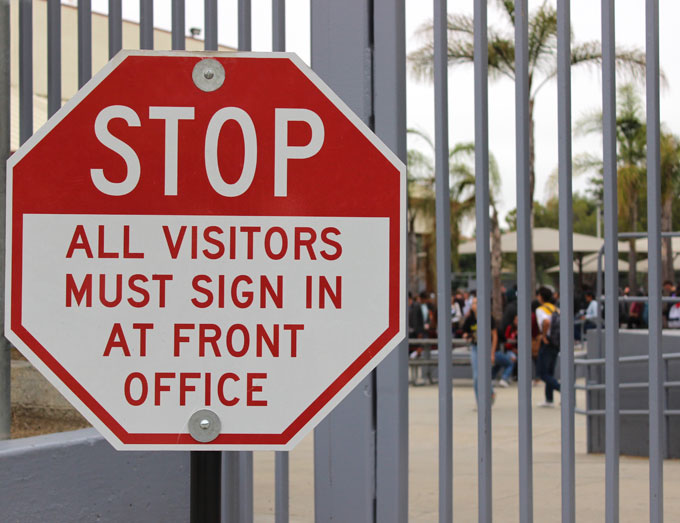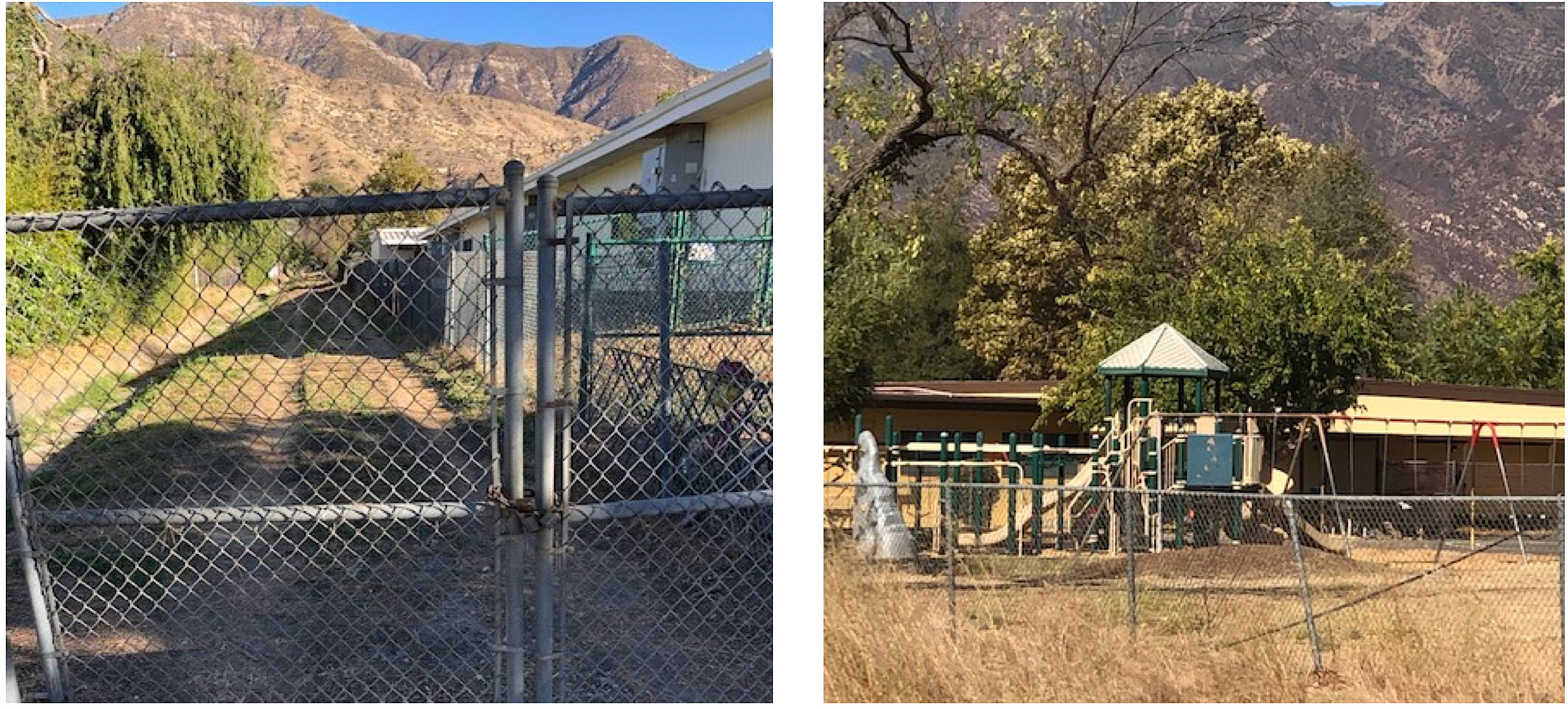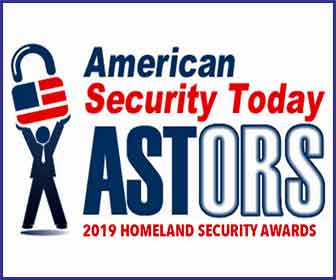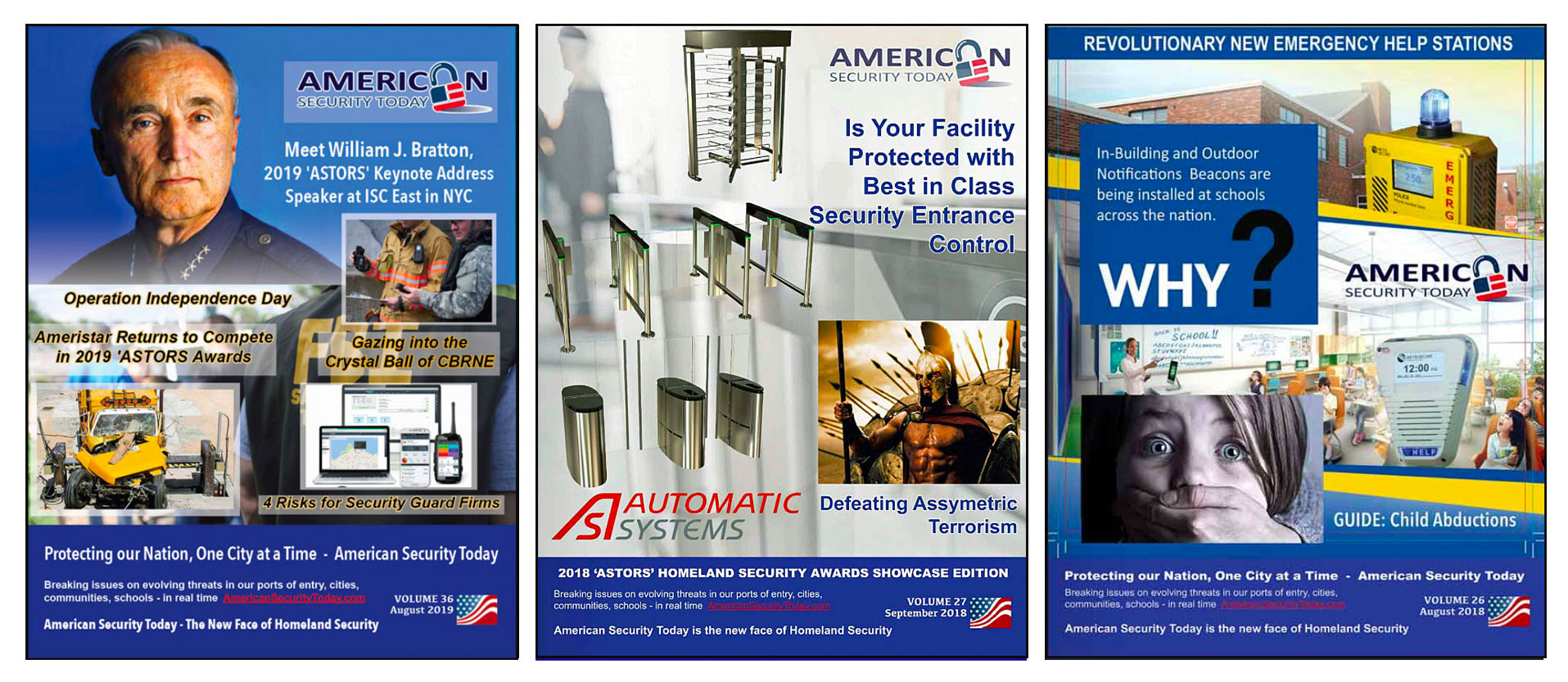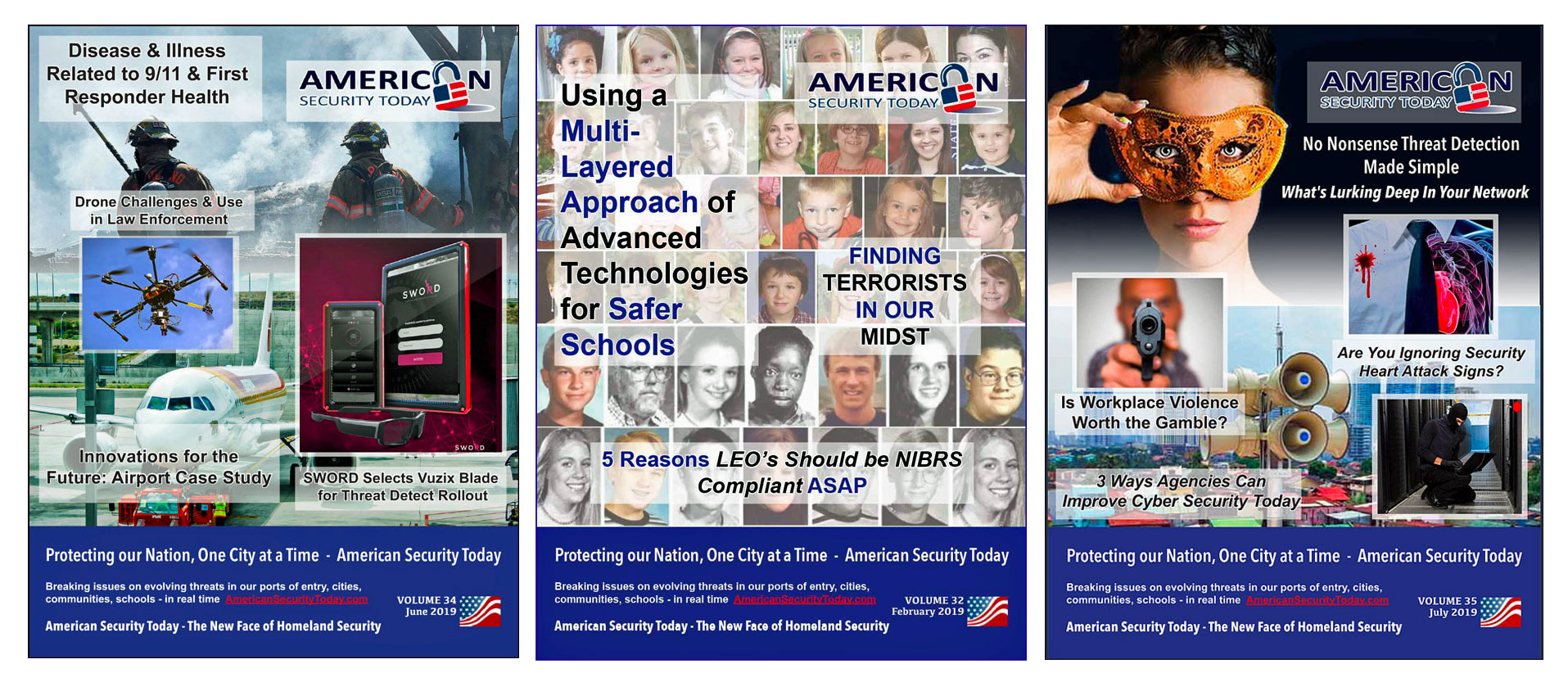
Guest OpEd By Doug Haines, Owner, Haines Security Solutions
A couple of months ago, I was watching a news report about a kid who was bullied, beaten and died from the injuries inflicted on him by his classmates.
The reporter was interviewing the principal about how something like this could happen at the school when they had security in place.
The principal said something along the lines of, “I can’t understand how this could happen we have cameras and a resource officer”.
My blood curdled.
(13 year old Diego, whose head struck a concrete pillar after he was punched by another boy at a Moreno Valley middle school, has died of his injuries. Courtesy of CBS Los Angeles and YouTube. Posted on Sep 25, 2019.)
I wanted to reach through the TV and grab the principal by the face.
After yelling at the TV, my wife was able to calm me down enough so that I could rationalize why I was so angry.
I soon realized, that it really wasn’t the principal’s fault in responding the way he did, because he really had no idea as to what security is or isn’t, even though he is responsible for the safety of all his students, teachers, administrators, visitors and more.
Unfortunately, he had been doing what so many other administrators, office and facility managers have been doing to ‘deter, prevent and defend against violence’ in our schools.
He bought into the ‘sales pitch’: “If one camera, resource officer or gun is good then two must be better and three… well; and as long as there’s robust access control and we can keep the threat out and we’ll all be okay.”
The truth is he was trying to solve behavioral issues with physical security applications.
Now, I’m not a psychologist and haven’t had formal training on analyzing adolescent behavior other than having lived through my own son’s teenage years as a parent.
But I do know this, all the cameras, resource officers, guns on campus (even in the hands of the “good guys”) plus access control systems in the world, cannot prevent a bad thing from happening alone.
Addressing just the physical environment is not enough. The behavioral environment must also be addressed with equal importance.
The psychology behind why people do what they do, is part of the multi-facet complications of the security puzzle.
That said, in order to have proper physical security, mitigation strategist and those responsible must understand the types of aggressor groups, what motivates them and the tools they need in order to be successful.
Aggressors fall into four main categories:
-
Criminals (sophisticated/unsophisticated, organized/unorganized)
-
Protesters (organized/unorganized)
-
Terrorist (domestic/transnational/State sponsored) and subversives (intelligence agents [State/non-State sponsored])
Furthermore, there are four main aggressor objectives:
-
To inflict injury or death on people
-
To destroy or damage equipment, facilities or other resources
-
To steal equipment, material or information, and
-
To create adverse publicity
Tools on the other hand, don’t fall into any category and are virtually unlimited.
Unfortunately, the security industry has been approaching school security from the wrong angle.
We keep thinking, ‘if one is good two must be better and we can harden our way to a perfect world.’ We cannot.
School shootings and other incidents of mass violence will continue, I am disappointed to say, until we begin addressing and eliminating the causes that promote these types of behavior.
School systems have developed a variety of multi-disciplinary programs that address prevention and response to mental health issues – if a student manifests behavior that might precipitate violence on a grand scale; i.e., bullying, addiction and interpersonal violence. But still, this is not enough.
Some security companies offer “social media behavioral monitoring” and are analyzing a person’s social media presence in “real time” and reporting actionable intelligence of patterns or suspicious behaviors to authorities, but this alone, again is not enough.
Using artificial intelligence, and deep learning are great but they’re just another tool.
However, just because a person manifests some type of anxiety or disruptive behavior does not necessarily indicate they will act out, and it does not mean that this individual will become a school shooter.
Based on my experience it is my educated belief that we need to get to the cause of the angst.
Why does a “perfectly normal kid” decide to take a gun into a school and begin shooting?
Could traditional mitigation strategies which result in a “prison look” of many schools contribute to this phenomenon?
Is it possible, that the chain-linked fence surrounding the school yard, the metal detector that everyone passes through and the roaming armed guard all contribute in some way?
Just because those increasingly culturally accepted strategies have become the “new normal” – does not mean that every child exposed to these environments will grow up and commit a criminal act.
However, there is substantial evidence indicating that they will carry a certain degree of angst with them into adulthood, in part based on social engineering resulting from these environments.
We as a society do not have to look far to see examples of this imposing ‘big dog,’ or ‘in your face’ approach which carries with it the subliminal messaging that ‘something bad’ is likely to happen.
Visiting Las Vegas of late for instance, you cannot help but take note of approximately four and a half miles of shiny metal bollards of substantial size placed every four to five feet along the Las Vegas Strip.
(More steel bollards are scheduled to be installed along the Las Vegas Strip to bring the total number to about 4,600, according to a county spokesman. Courtesy of KSNV News 3 Las Vegas and YouTube. Posted on May 24, 2019.)
That being said, casino-hopping visitors have repeatedly expressed anxiety, angst and extreme discomfort crossing streets at the crosswalks.
Firstly, city planners have not implemented any design mitigation strategies in the roadways to require reduced vehicular traffic, so vehicles can obtain considerable speed before potentially hitting pedestrians within crosswalks.
Secondly, many of the islands where pedestrians wait for the light are unprotected.
Furthermore, the effect of massive bollards along the strip can result in an emotional response to indicate “They are expecting something to happen here, and if it’s happening here in Vegas, perhaps the traditional ‘prison look’ strategies mean that it could also happen to our kids in school.

However, along the Strip there are other areas which are not protected by massive bollards.
They have been designed to provide the same level of protection in keeping a high-speed vehicle from intentionally or unintentionally ramming into pedestrians but instead use thoughtful hardscaping and landscaping.
We can address behavior in the built environment in a non-traditional way as a substitute to the confrontational ‘in your face’ approach.
The approach should be more subtle, in fact, the more transparent it is the more effective it will be.
Normally, to deter crime, we put up signs that say, “Cameras in Use” and some folks get creative saying, “Smile you’re on camera”.
For access control, we traditionally mark our territory by placing a chain-linked fence or some other type of “barrier” on our boundary-line. It has a limited effect because a truly dedicated threat will bring the tools needed to circumvent it.
Build a big fence; they’ll bring a bigger ladder. Make it even higher and they’ll bring an even bigger ladder or tunnel under it.
Sure, there is a degree of deterrent, however, a dedicated “bad actor” will bring the tools needed in order to be successful.
Research shows that the concepts of natural surveillance, natural access control, territorial reinforcement and maintenance contribute to the deterrence and reduction of criminal activity.
In the early 1990’s, Crime Prevention through Environmental Design (CPTED) principles, one such technology utilized in the development of neighborhoods by the National Institute of Crime Prevention (NICP), was introduced to connect these two worlds – unwanted behavior and a physical deterrent.
The basic concept of CPTED is if we can design the space so that it is almost always under observation “bad actors” won’t act badly.
I believe it has the potential to go even further than that.
Not only do we need to design the space using these concepts, but we also must design the space so that “acting badly” cannot occur.
Additionally, in the off chance it does the built environment should help to reduce its effects and not contribute to its severity.
Cities and Counties throughout the country are adopting CPTED ordinances which require site plan reviews with crime prevention in mind; with law enforcement officers who are specially trained in CPTED work closely with planners, architects, city officials, and educators to ensure the proper design of structures, schools, and neighborhoods.
CPTED participants learn how the design and use of the environment can control human/criminal behavior and reduce the fear of crime, through natural means.
How natural access control and natural surveillance decrease the opportunity for crime.
(CPTED looks at the environment in which crime can occur and designs areas to make them safer and more appealing to live or work in. Courtesy of Christchurch City Council Civic Offices and YouTube. Posted on Apr 3, 2016.)
Communities utilizing CPTED principles tend to thrive economically and socially.
A couple of years ago researchers in the European Union conducted a survey, asking elementary school children who had emigrated from a war-torn country to draw what they considered ‘safety’ or ‘security’ to be.
These children drew pictures of fencing with razor-wire and ‘gunships’ overhead.
The researchers then asked the same question to European children who had not be exposed to hostile environments, and those children drew houses with trees, stick families, a dog and sunshine.
Shouldn’t we be striving for the ‘sunshine’ scenario?
There is some truth to the traditional concept that the harder we make it for the ‘bad guy’ to do ‘bad things’ the more of a deterrent there is.
 However, truly ‘bad people’ will always find a way to circumvent it, which in turn defeats its purpose.
However, truly ‘bad people’ will always find a way to circumvent it, which in turn defeats its purpose.
Moving away from traditional methods of hardening schools after every new incident occurs by using ‘big dog’ philosophies will take time, nonetheless, we can begin immediately to search out innovative ways to create environments that are provide the same levels of security, while also providing a mixture of color and natural materials which are much more soothing and aesthetically pleasing.
I submit that beginning this school year, administrators should use the checklist provided by the Partner Alliance for School Safety (PASSK-12) to conduct a physical security risk assessment of their campus and whenever possible replace traditional mitigation solutions they would normally opt for with a hardscaping, landscaping or art strategy.
Creativity and student, staff and community involvement are essential.
Success in security is sloppy. It’s entangled.

It’s very hard to distinguish where detection, assessment, policy and procedures, response and engagement begin and end.
Addressing behavior must be coupled with addressing the physical environment. They require a different amount of time, effort and commitment to produce positive results but nonetheless are equally important.
In order for students, who eventually become adults in our society, to thrive we must begin create environments, internal and external, that foster “well-being” in both the social and physical ecosystems, and if we can do that in a more aesthetically pleasing way, then why not?
About the Author
Doug Haines, owner of Haines Security Solutions, LLC (HSS), is a United States Air Force veteran with over 45 years of law enforcement and security related experience, which includes teaching building design principles to architects, engineers, facility managers, planners, and security professionals.

He is a distinguished judge on the Annual ‘ASTORS’ Homeland Security Awards Judges Panel, and a regular expert contributor to AST, sharing his years of experience and insights with our 75K+ readers.
Doug’s company HSS, is recognized as a center of expertise within the security community for risk assessment, providing services for many federal; State, local government agencies and private companies around the globe, and is a founding member of International Centers of Security Training Excellence (ICSTE).
Each ICSTE member company offers courses in one of several security verticals yet provides a location for other members to present their courses upon request.

At its River Park facility in Oxnard, CA architects, engineers, facility managers, planners and security professionals learn about antiterrorism countermeasures in building design, the integration of security technologies in the built environment, and risk analysis strategies.
The CPK-United BV (also an ICSTE founding member) training facility in Hilversum, The Netherlands gears its curriculum towards fashion retail, hospitality (hotel and nightclubs) and port security guard activities and executive protection.
Tactics for patrolman and SWAT are taught by former police officers at the Greenville, NY training center, where a firing range and urban mock-up are on site.
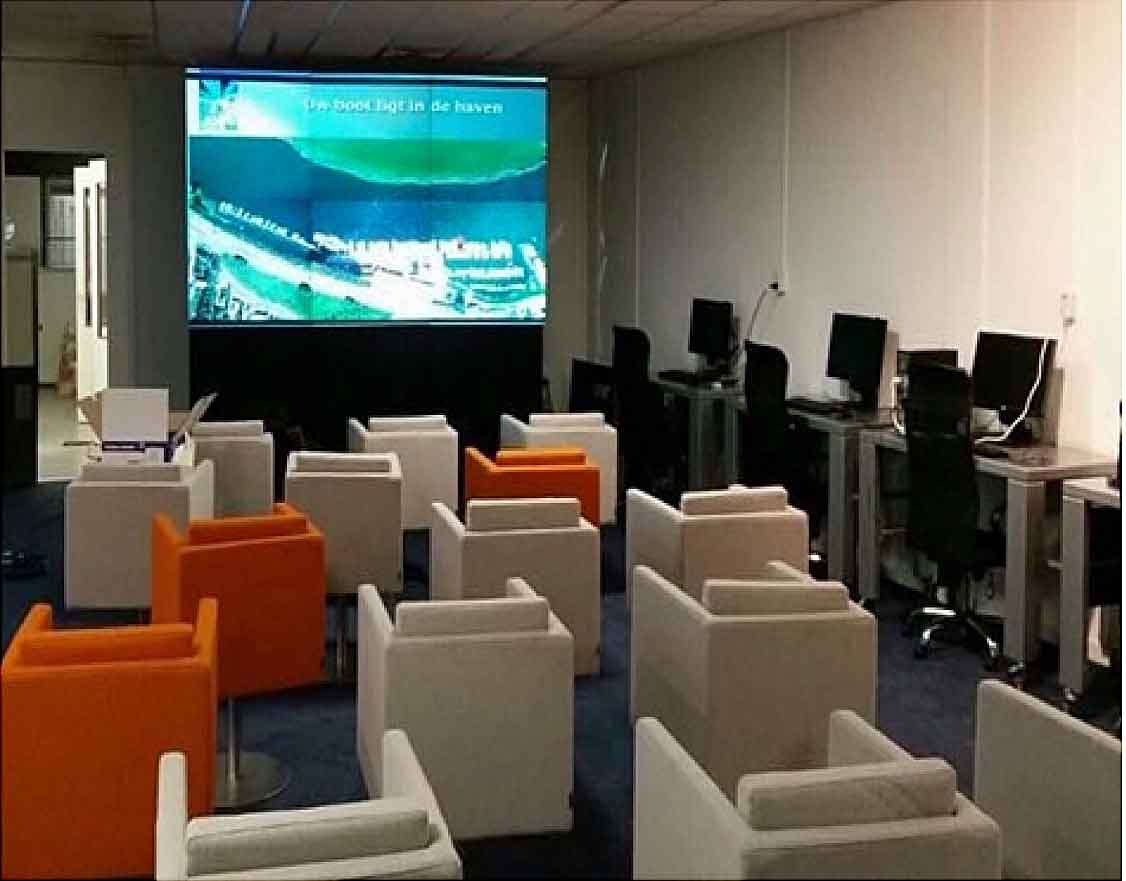
In 2017, HSS’s Physical Security Engineering Training and Certification (PSET&C) program was recognized as the Best Homeland Security Education Program, by American Security Today and received a coveted Platinum ‘ASTORS’ Award.
More information about ABRA, CAIRA, ICSTE or other services can be found on the company’s website at www.hainessecuritysolutions.com.
Haines Security Solutions is a contributor to the Security Industry Association’s education platform, “Center of Excellence” at https://www.securityindustry.org/center-of-excellence/.
Haines Security Solutions (HSS) Honored in 2019 ‘ASTORS’ Homeland Security Awards for Fourth Consecutive Year
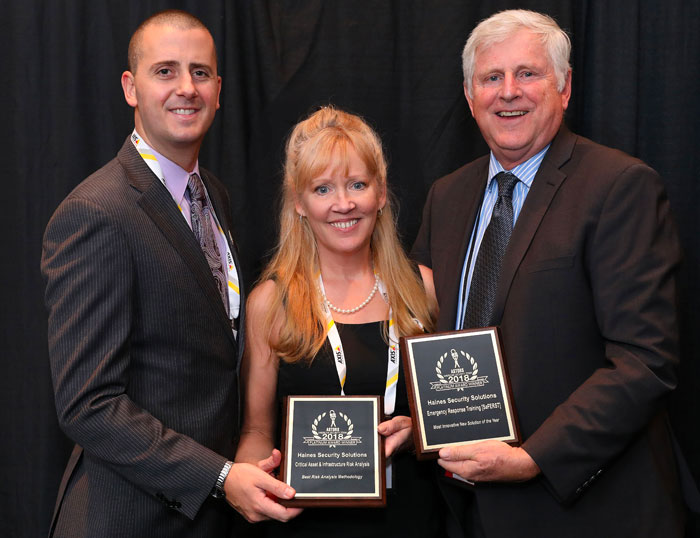
Haines Security Solutions
-
-
-
Best Use of Multiple Technologies
-
-
-
SaFEspace
-
Secure and Friendly Emergency Space (SaFEspace) innovative designs allows for any occupied space, private or public, to be designed with ballistic protective technologies using Amulet™ ballistic resistant composite material that is lighter and more manageable for installation than other off-the-shelf bullet resistant technologies.
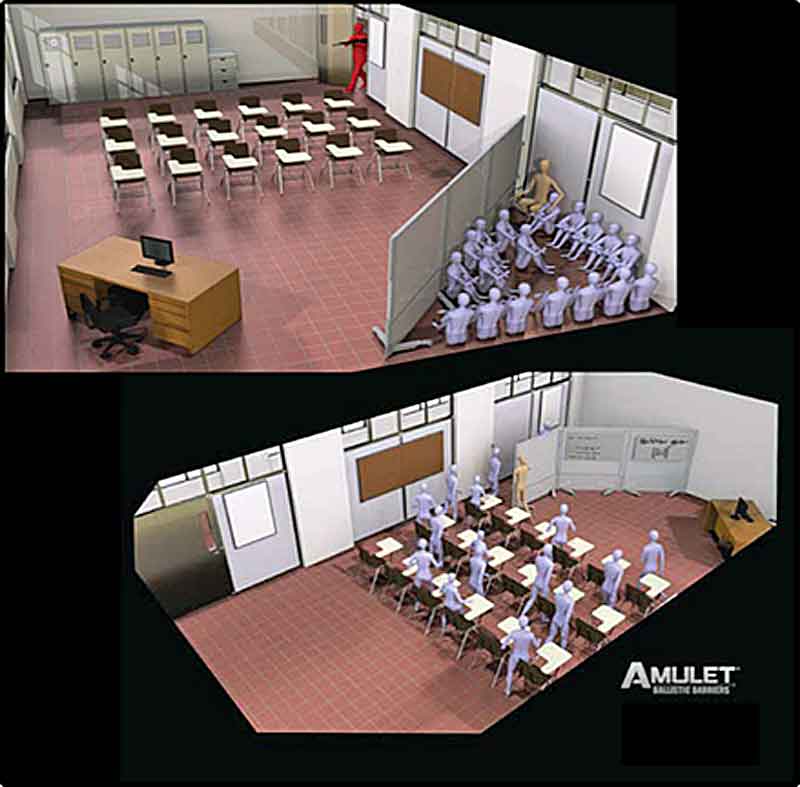
-
SaFEspace comes in two configurations; one temporary and one more permanent.
-
The temporary solution involves using portable wall-panels – MobileBoards™ (incorporating Amulet™ protective technologies) while allowing daily whiteboard surface usage. In an emergency, occupants can quickly pull the conference room panel that had been used during their meeting just moments before into a safer corner of the room to take shelter behind it.
-
The more permanent solutions involve wall panels that fold-out and in essence form a room-within-a-room.

-
The wall panels have shot-detection capabilities and can decipher caliber signatures and distance, which is extremely beneficial for responding law enforcement personnel in identifying where the shooter is and what type of weapon(s) is being used.
-
The newly created “room” if you will, can be locked from the inside and unlocked remotely by police or fire officials. Additionally, SaFEspace has an intercom system, so that the occupants can communicate with responding forces.
Enter today to Compete in the 2020 ‘ASTORS’ Homeland SecurityAwards at https://americansecuritytoday.com/ast-awards/.
The Annual ‘ASTORS’ Awards Program is specifically designed to honor distinguished government and vendor solutions that deliver enhanced value, benefit and intelligence to end users in a variety of government, homeland security and public safety vertical markets.

The Annual ‘ASTORS’ Awards is the preeminent U.S. Homeland Security Awards Program highlighting the most cutting-edge and forward-thinking security solutions coming onto the market today, to ensure our readers have the information they need to stay ahead of the competition, and keep our Nation safe – one facility, street, and city at a time.
American Security Today is pleased to announce that Deann Criswell, the NYC Emergency Management Commissioner will deliver the keynote address at the 2020 ‘ASTORS’ Awards Presentation Luncheon Banquet in New York City.
Nominations are now being accepted for the 2020 ‘ASTORS’ Homeland Security Awards at https://americansecuritytoday.com/ast-awards/.
Comprehensive List of Categories Include:
| Access Control/ Identification | Personal/Protective Equipment | Law Enforcement Counter Terrorism |
| Perimeter Barrier/ Deterrent System | Interagency Interdiction Operation | Cloud Computing/Storage Solution |
| Facial/IRIS Recognition | Body Worn Video Product | Cyber Security |
| Video Surveillance/VMS | Mobile Technology | Anti-Malware |
| Audio Analytics | Disaster Preparedness | ID Management |
| Thermal/Infrared Camera | Mass Notification System | Fire & Safety |
| Metal/Weapon Detection | Rescue Operations | Critical Infrastructure |
| License Plate Recognition | Detection Products | And Many Others! |
Don’t see a Direct Hit for your Product, Agency or Organization?
Submit your category recommendation for consideration to Michael Madsen, AST Publisher at: mmadsen@americansecuritytoday.com.
The 2019 ‘ASTORS’ Awards Program surpassed expectations with a record number of nominations received from industry leaders and government agencies, and drew over 200 attendees to the ‘ASTORS’ Awards Presentation Banquet – an exclusive gourmet luncheon and networking opportunity which filled to capacity, before having to turn away late registrants.

The event featured an impassioned and compelling keynote address by William J. Bratton, former police commissioner of the New York Police Department (NYPD) twice, the Boston Police Department (BPD), and former chief of the Los Angeles Police Department (LAPD), as he walked attendees through 50 years of American policing history, the impacts on the communities, and the evolution of critical communication capabilities in our post 9/11 landscape.
Commissioner Bratton, one of the world’s most respected and trusted experts on risk and security issues and Executive Chairman of Teneo Risk a global advisory firm, was recognized as the ‘2019 ‘ASTORS’ Person of the Year’ for his Lifetime of Dedication and Extraordinary Leadership in Homeland Security and Public Safety.
Why the ‘ASTORS’ Homeland Security Awards Program?

American Security Today’s comprehensive Annual Homeland Security Awards Program is organized to recognize the most distinguished vendors of physical, IT, port security, law enforcement, and first responders, in acknowledgment of their outstanding efforts to ‘Keep our Nation Secure, One City at a Time.’
Over 200 distinguished guests representing Federal, State and Local Governments, and Industry Leading Corporate Firms, gathered from across North America, Europe and the Middle East to be honored among their peers in their respective fields which included:
- The Drug Enforcement Administration (DEA)
- National Center for Missing and Exploited Children (NCMEC)
- United States Marine Corps
- The Federal Protective Service (FPS)
- Argonne National Laboratory (ANL)
- United States Postal Inspection Service
- DHS S&T
- United States Marshals Service (USMS)
- The Port Authority of New York & New Jersey Police (PAPD)
- The Department of Justice (DOJ)
- The New York State Division of Homeland Security & Emergency Services (NYS DHSES)
- United States Border Patrol
- AlertMedia, Ameristar Perimeter Security, Attivo Networks, Automatic Systems, Bellevue University, BriefCam, Canon U.S.A., CornellCookson, Drone Aviation, FLIR Systems, Hanwha Techwin, HID Global, IPVideo Corp., Konica Minolta Business Solutions, LenelS2, ManTech, Regroup Mass Notifications, SafeLogic, SolarWinds, Senstar, ShotSpotter, Smiths Detection, TCOM LP, Trackforce, Verint, and More!
Why American Security Today?
The traditional security marketplace has long been covered by a host of publications putting forward the old school basics to what is Today – a fast changing security landscape.
The traditional security marketplace has long been covered by a host of publications putting forward the old school basics to what is Today – a fast changing security landscape.
American Security Today is uniquely focused on the broader Homeland Security & Public Safety marketplace with over 75,000 readers at the Federal, State and local levels of government as well as firms allied to government.
American Security Today brings forward a fresh compelling look and read with our customized digital publications that hold readers eyes throughout the story with cutting edge editorial that provides solutions to their challenges.
Harness the Power of the Web – with our 100% Mobile Friendly Publications

The AST Digital Publications is distributed to over 75,000 qualified government and homeland security professionals in federal, state and local levels.
‘PROTECTING OUR NATION, ONE CITY AT A TIME’
AST Reaches both Private & Public Experts, essential to meeting these new challenges.
Today’s new generation of public safety and security experts need real-time knowledge to deal with domestic and international terrorism, lone wolf attacks, unprecedented urban violence, shifts in society, culture and media bias – making it increasingly difficult for Homeland Security, Law Enforcement, First Responders, Military and Private Security Professionals to implement coordinated security measures to ensure national security and improve public safety.
These experts are from Government at the federal, state and local level as well as from private firms allied to government.
AST provides a full plate of topics in our AST Monthly Magazine Editions, AST Website and AST Daily News Alerts, covering 23 Vital Sectors such as Access Control, Perimeter Protection, Video Surveillance/Analytics, Airport Security, Border Security, CBRNE Detection, Border Security, Ports, Cybersecurity, Networking Security, Encryption, Law Enforcement, First Responders, Campus Security, Security Services, Corporate Facilities, and Emergency Response among others.
AST has Expanded readership into integral Critical Infrastructure audiences such as Protection of Nuclear Facilities, Water Plants & Dams, Bridges & Tunnels, and other potential targets of terrorism.
Other areas of concern include Transportation Hubs, Public Assemblies, Government Facilities, Sporting & Concert Stadiums, our Nation’s Schools & Universities, and Commercial Business Destinations – all enticing targets due to the large number of persons and resources clustered together.
To learn more about the 2019 ‘ASTORS’ Homeland Security Award Winners solutions, please go to the 2019 ‘ASTORS’ Championship Edition Fully Interactive Magazine – the Best Products of 2019 ‘A Year in Review’.
The ‘ASTORS’ Champion Edition is published annually and includes a review of the ‘ASTORS’ Award Winning products and programs, highlighting key details on many of the winning firms products and services, includes video interviews and more.
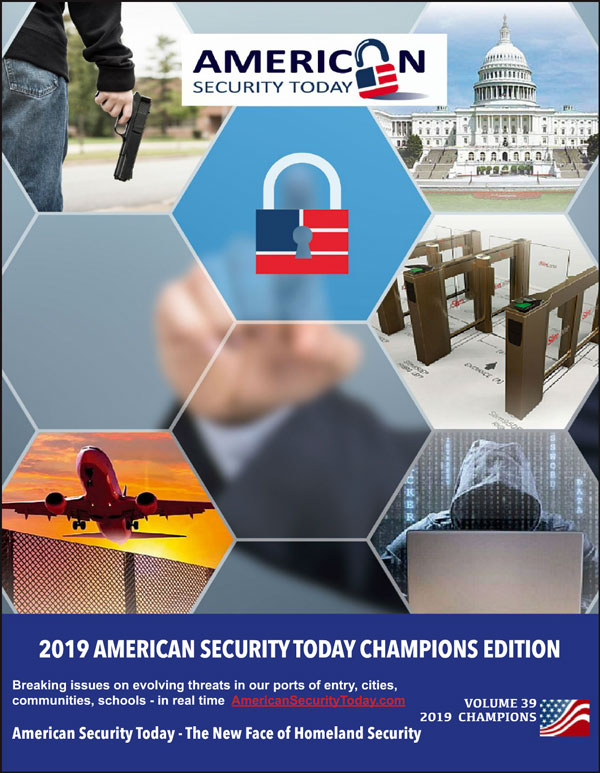 It is your Go-To source throughout the year for ‘The Best of 2019 Products and Services‘ endorsed by American Security Today, and can satisfy your agency’s and organization’s most pressing Homeland Security and Public Safety needs.
It is your Go-To source throughout the year for ‘The Best of 2019 Products and Services‘ endorsed by American Security Today, and can satisfy your agency’s and organization’s most pressing Homeland Security and Public Safety needs.
From Physical Security (Access Control, Critical Infrastructure, Perimeter Protection and Video Surveillance Cameras and Video Management Systems), to IT Security (Cybersecurity, Encryption, Data Storage, Anti-Malware and Networking Security – Just to name a few), the 2019 ‘ASTORS’ CHAMPIONS EDITION will have what you need to Detect, Delay, Respond to, and Mitgate today’s real-time threats in our constantly evolving security landscape.
It also includes featured guest editorial pieces from some of the security industry’s most respected leaders, and recognized firms in the 2019 ‘ASTORS’ Awards Program.
Haines Security Solutions (HSS) is a veteran owned company that specializes in providing high-quality professional security consulting services relating to antiterrorism and personal protection.
 HSS has extensive experience in developing security criteria for businesses and government agencies, and conducts asset specific threat/vulnerability and risk analysis using quanitative risk analysis and provides sensible mitigation strategies.
HSS has extensive experience in developing security criteria for businesses and government agencies, and conducts asset specific threat/vulnerability and risk analysis using quanitative risk analysis and provides sensible mitigation strategies.
HSS conducts security engineering workshops and a variety of other security related training around-the-globe. Key Staff assists with the development of training plans, drills and exercise curriculum.
Learn More by visiting https://www.hainessecuritysolutions.com/.
For information about advertising opportunities with American Security Today, please contact Michael Madsen, AST Publisher at mmadsen@americansecuritytoday.com.
AST strives to meet a 3 STAR trustworthiness rating, based on the following criteria:
- Provides named sources
- Reported by more than one notable outlet
- Includes supporting video, direct statements, or photos
Subscribe to the AST Daily News Alert Here.
Learn More…
Don’t Surrender to Fear: New Book – ‘The Solutions Matrix’ by Doug Haines














